The WSL made its long-awaited return last weekend, with new teams, players and managers all looking to begin the season in the best way possible. Arsenal Women hosting Chelsea Women was undoubtedly the tie of the first round of matches, and two of the league’s title contenders put on an outstanding footballing display at the Emirates Stadium. However, when it came to both teams’ performances, Arsenal had the edge over their opponents, and this tactical analysis will look at why that was. We will see why Chelsea’s tactics were well-thought-out, but had flaws, and why Arsenal’s attacking and counter-attacking play was essential to their win, and why it provided us with an insight into how they might set up during the remainder of the campaign.
Lineups

Arsenal Women named a 4-3-3 formation for Jonas Eidevall’s first league game in charge, with Switzerland defender Noelle Maritz playing at right-back, Republic of Ireland international Katie McCabe in her usual left-back position, and Jennifer Beattie partnering England’s Leah Williamson in central defence, with Lotte Wubben-Moy and Anna Patten both on the bench. Captain Kim Little, who recently retired from the Scotland national team, started in midfield, alongside Switzerland’s Lia Walti and new signing Frida Maanum, whilst the forward line was made up of Beth Mead and another new signing, Mana Iwabuchi, both of whom played either side of star Netherlands striker Vivianne Miedema.
Chelsea Women, meanwhile, named a 3-4-3 starting formation; something that we don’t usually associate with them. However, with the majority of those who featured at the Olympics deemed not ready to start this game, Emma Hayes named Jess Carter, Millie Bright and captain Magdalena Eriksson as a back three, whilst former Liverpool Women player Niamh Charles and Norway forward Guro Reiten were given the wing-back roles. South Korea international Ji So-yun and Germany’s ex-Bayern Munich Frauen player Melanie Leupolz operated in the midfield, whilst Beth England started as the centre forward, flanked by Scotland star Erin Cuthbert, who was unfortunate to miss out on the Team GB squad, and Denmark star Pernille Harder.
Chelsea Women’s tactics
Chelsea Women are tipped by many to hold on to their WSL crown this season, and Emma Hayes has strengthened her squad with the signings of forward Lauren James from Manchester United Women and Netherlands defender Aniek Nouwen from PSV Vrouwen. However, this game was never going to be easy for them, and they needed to have a good start in order to take early control of the match.

It was clear from the early stages that they were playing a counter-attacking style of football, allowing Arsenal Women to have the ball and countering at pace when they won possession. In this image, we can see how even the forward line were involved in this tactic, with Pernille Harder going forward to gently press the Arsenal defender, but not with enough intensity to force a turnover. However, they didn’t press as a team, and also didn’t go forward every time the ball moved to the next Arsenal player, which indicated that their focus was not on having possession.
As a result, Arsenal dominated the first stages of the first half, with time to look for the best spaces before moving the ball on, and the defensive line was also allowed to spread out and make the pitch as big as possible.

However, when Arsenal did lose possession, Chelsea’s attacking setup was organised, with the wing-backs controlling the wide channels, whilst the three attackers became compact in the middle, as this image illustrates. As a result of the three-pronged central attack, Arsenal’s defence had to narrow up to prevent Harder, England or Cuthbert from accessing the space behind.
Whilst this in theory was a good structure, it didn’t quite work as planned for Chelsea. Niamh Charles operated as a right-back in some games last season, so knows the role in both attacking and defensive situations of a full-back or wing-back. Reiten, meanwhile, is more used to playing in the final third and staying there, and looked out of her comfort zone in this system as a result. Chelsea’s attack was therefore lopsided at times, meaning that they struggled to make the most of the opportunities they created.

Key to Chelsea’s good play was Ji So-yun. She was undoubtedly the best player on the pitch for Emma Hayes’ side, constantly finding spaces and linking up play for her team. On this occasion, she has dropped back to help out the defence, receiving the ball from them and turning to play it forwards, but she was also involved in a lot of quick play at the other end of the pitch, and always tried to create goalscoring opportunities for either herself or a teammate. It was obvious that she had been given the playmaker role for this game, as other Chelsea players constantly gave her passing options whenever she had possession, knowing that she wanted to play into space around the field every time the ball came to her.
In the context of this season, Ji could be a key player in Chelsea’s transitional play, and teams will need to close her down quickly in order to prevent Chelsea from posing a threat.
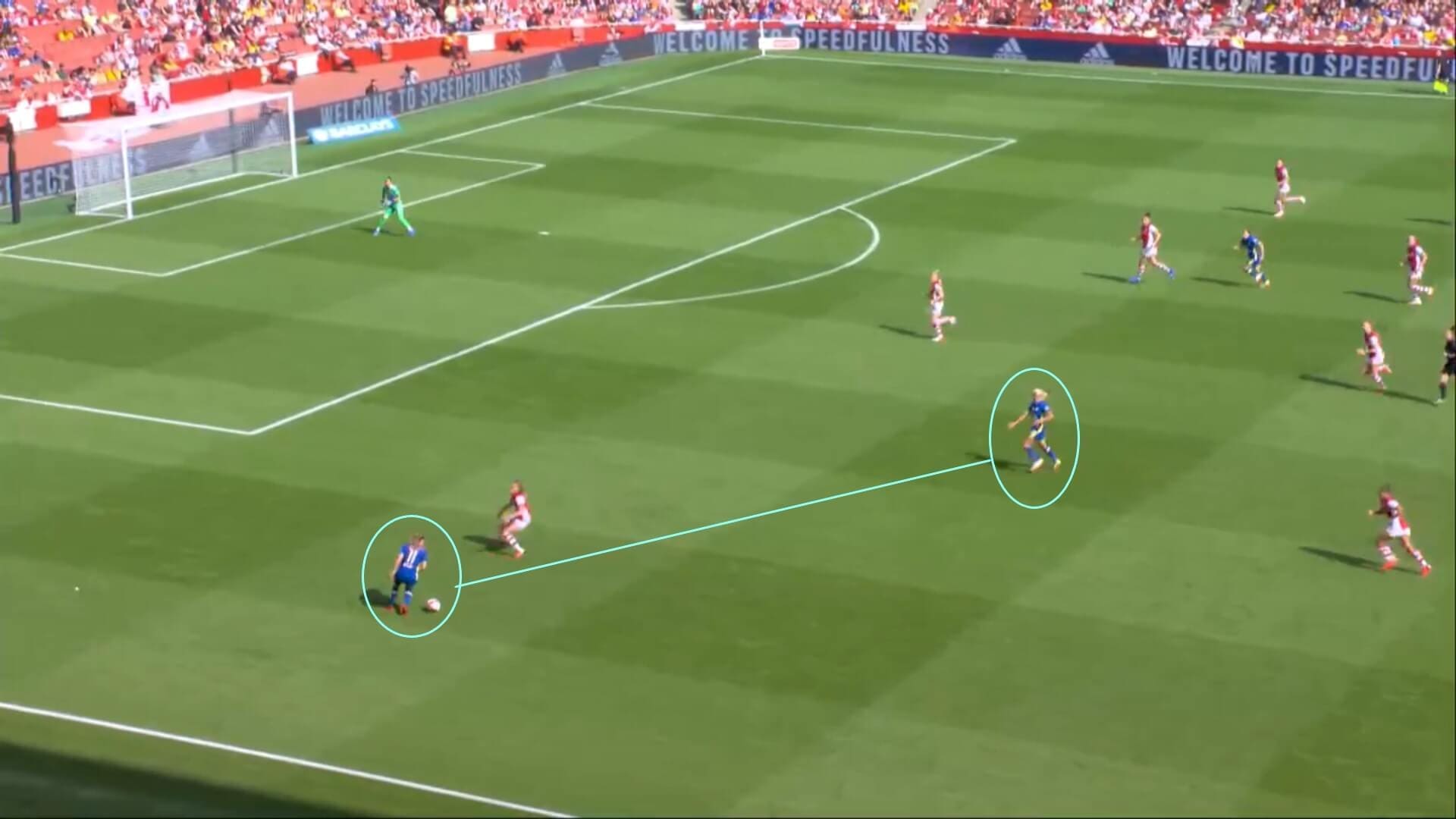
In the first half, the wide forwards and wing-backs combined with each other in the wide channels, but not as often as was needed, and this was one reason for Chelsea’s struggles. However, whilst Reiten lacked her usual impact on proceedings before half-time, she was far more dangerous afterwards, and it seemed like Emma Hayes had given her more encouragement to advance up the field in the second half. As this image indicates, her positioning was much better, giving Chelsea more passing options when they were needed.
Thinking tactically for a moment, Pernille Harder, on the inside of Reiten here, didn’t seem to have a fixed position last season, meaning she didn’t have as big an influence in key games as she perhaps might have done. However, this wing-back formation suited her style of play, as it allowed her to operate in the half-spaces, working with Reiten but also cutting inside and shooting at goal, and she looked more dangerous in this game. Whilst the 3-4-3 may not last, it might solve the question of the Denmark captain’s best position for Chelsea, which has been the subject of much debate since her arrival last summer, and Arsenal had to work hard to minimise her threat.
Chelsea Women’s errors
However, the fact that Arsenal Women won this match suggests that there were a few problems with Chelsea’s play, and that was indeed the case. For all their aforementioned pleasing moments in attack, they lacked quality with elements of their defending and build-up play.

The biggest issue, which was more noticeable in the second half, was their high defensive line. Carter, Bright and Eriksson continually advanced up the pitch, leaving a vast amount of open space behind them, and Arsenal looked to exploit this at every opportunity. Beth Mead tended to play on the shoulder of the Chelsea defenders, keeping them under pressure, and she was the main source of danger for Arsenal after half-time. Mead gave Arsenal a constant passing option behind the defence when they broke forward, and this was the reason that they scored twice through the former Sunderland Ladies forward in the first 15 minutes of the second half.
Whilst Chelsea goalkeeper Ann-Katrin Berger got the better of Mead on this occasion, the blue circle marks Guro Reiten’s attempt to get back. The distance between her and Mead is too great, though, which demonstrates how Chelsea caused their own problems at the back through their poor defensive positioning.
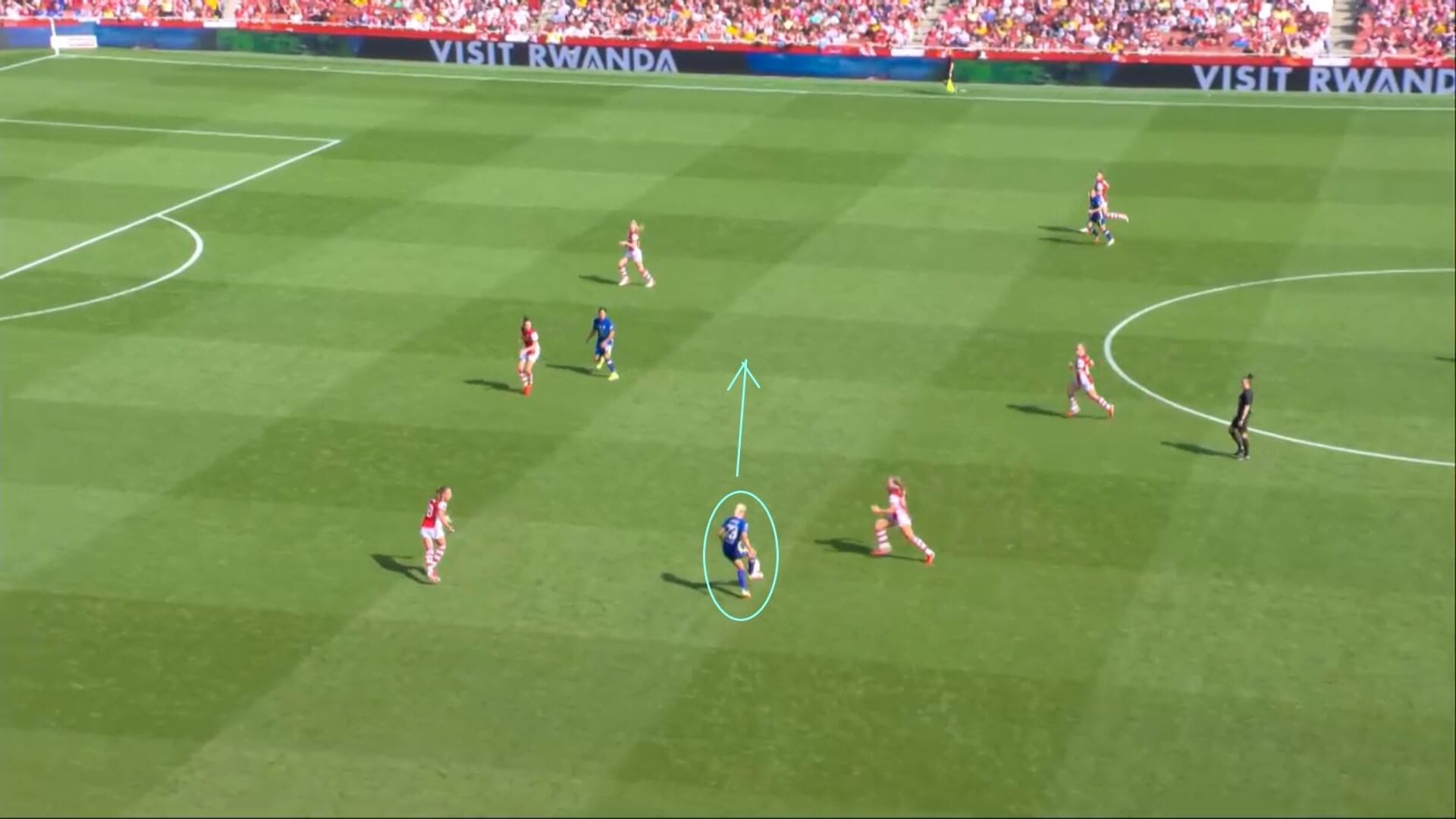
There were also issues with Chelsea’s passing at times, which allowed Arsenal to win back possession too easily, especially when Chelsea had claimed the ball through the home side’s occasionally poor decision-making. Here, Sam Kerr is in a good position to receive the ball and run at goal, but Harder’s pass into her lacked quality, instead going behind the Australia striker and allowing Arsenal to clear their lines. Kerr, who replaced Beth England in the second half, gave Arsenal more to think about than England had, and perhaps could have scored a goal, but moments like this showed how Chelsea as a team failed to make their opportunities count.
Overall, despite their good play, Chelsea’s performance was disjointed, with Beth England not having the desired impact, following speculation this summer about her future at the club, whilst midfielder Melanie Leupolz failed to settle into the game, resulting in her withdrawal early in the second half. Arsenal were predictably sharper, having already played three Champions League qualifying games against Kazakh side Okzhetpes, PSV and Sparta Prague, but what was surprising was how many problems Chelsea created for themselves, making it easier for Arsenal to win the game than it perhaps should have been.
Arsenal Women’s attacking play
We have so far looked at the good and bad of Chelsea Women’s tactical performance, but we will now turn our attention to Arsenal Women, analysing the attacking play which brought them their win.
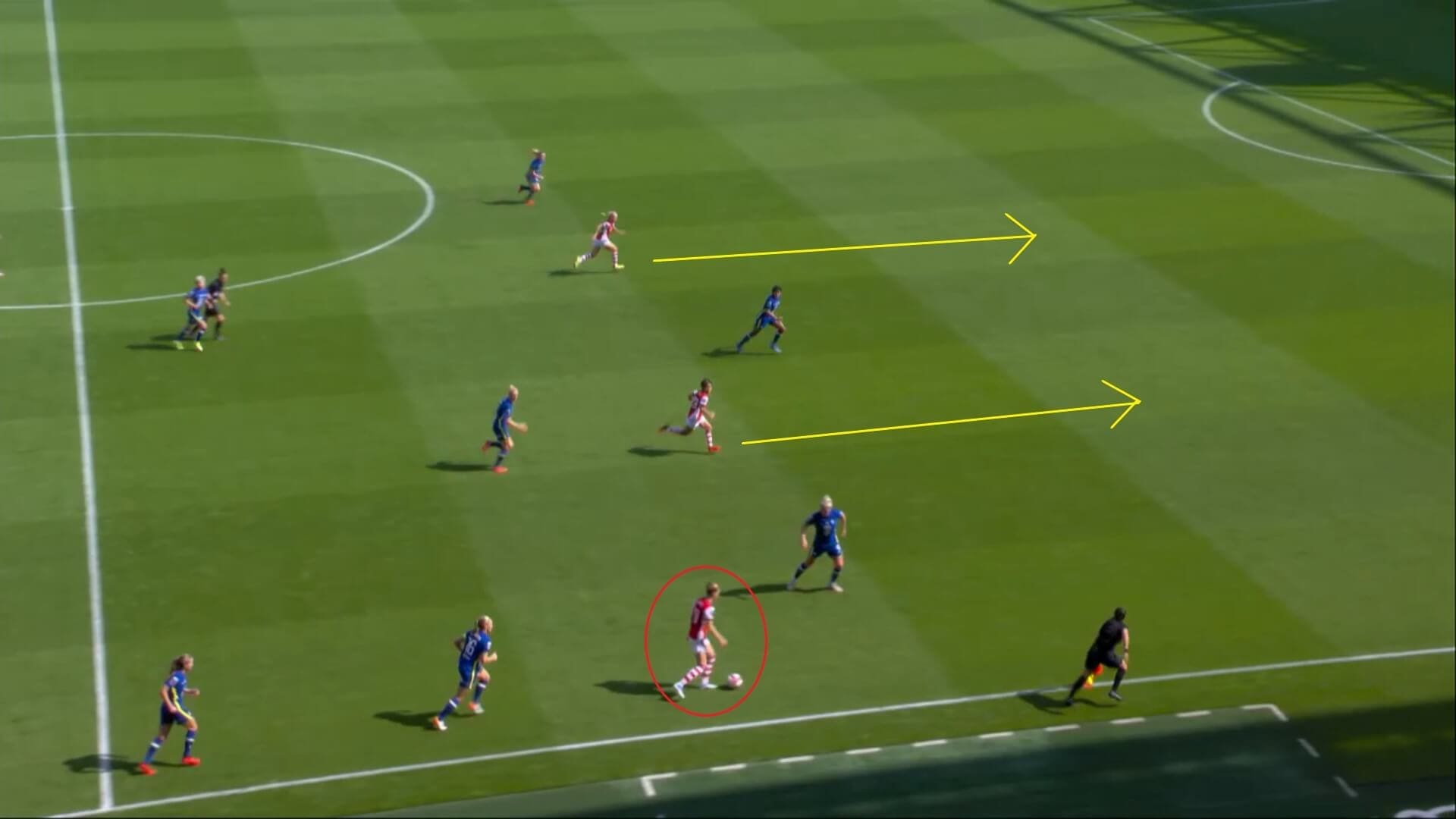
Jonas Eidevall likes his players to always have options available, and he has introduced a pass-and-move mentality to Arsenal this summer to help with that. This tactic was demonstrated in their attacking play against Chelsea, with Arsenal ensuring that there was always at least one player available to keep the attack alive. Here, we see how Vivianne Miedema has moved to the nearside wing, and is now turning and looking to pass the ball forwards, with Mana Iwabuchi and Beth Mead both running forward to give her options.
It is notable that both Japan international Iwabuchi, a summer arrival from Aston Villa Women, and Mead looked to expose the gaps in Chelsea’s defence, with their runs here highlighting once again the space that the defending champions gave them. This situation led directly to Mead’s second goal and Arsenal’s third, so it is clear to see that Arsenal’s quick passing created opportunities for them and increased Chelsea’s problems at the back.

The reason that the forward three could work together in tight spaces was due to left-back Katie McCabe’s advances up the wing, ensuring a constant supply of balls into the middle of Chelsea’s third. The reason that McCabe was able to abandon her defensive duties to do this was because Frida Maanum tended to drop into the left-back position to cover her when needed, as this image shows. The Norway international and former Linkopings captain is a versatile player, and Eidevall highlighted afterwards how this positional work was something that they had discussed beforehand, which demonstrates the detail that they went to in order to win the game.
Under previous manager Joe Montemurro (now in charge of Juventus Femmenile), Arsenal used a front three, but the wide forwards operated more as wingers, putting crosses into the box for Miedema to get on the end of. Under this new style of play, there is still a three-player forward line, but Iwabuchi and Mead played closer to the Dutch striker, as mentioned, giving Miedema more support and isolating the Chelsea back three, again showing the problems Arsenal caused their opponents in this game.
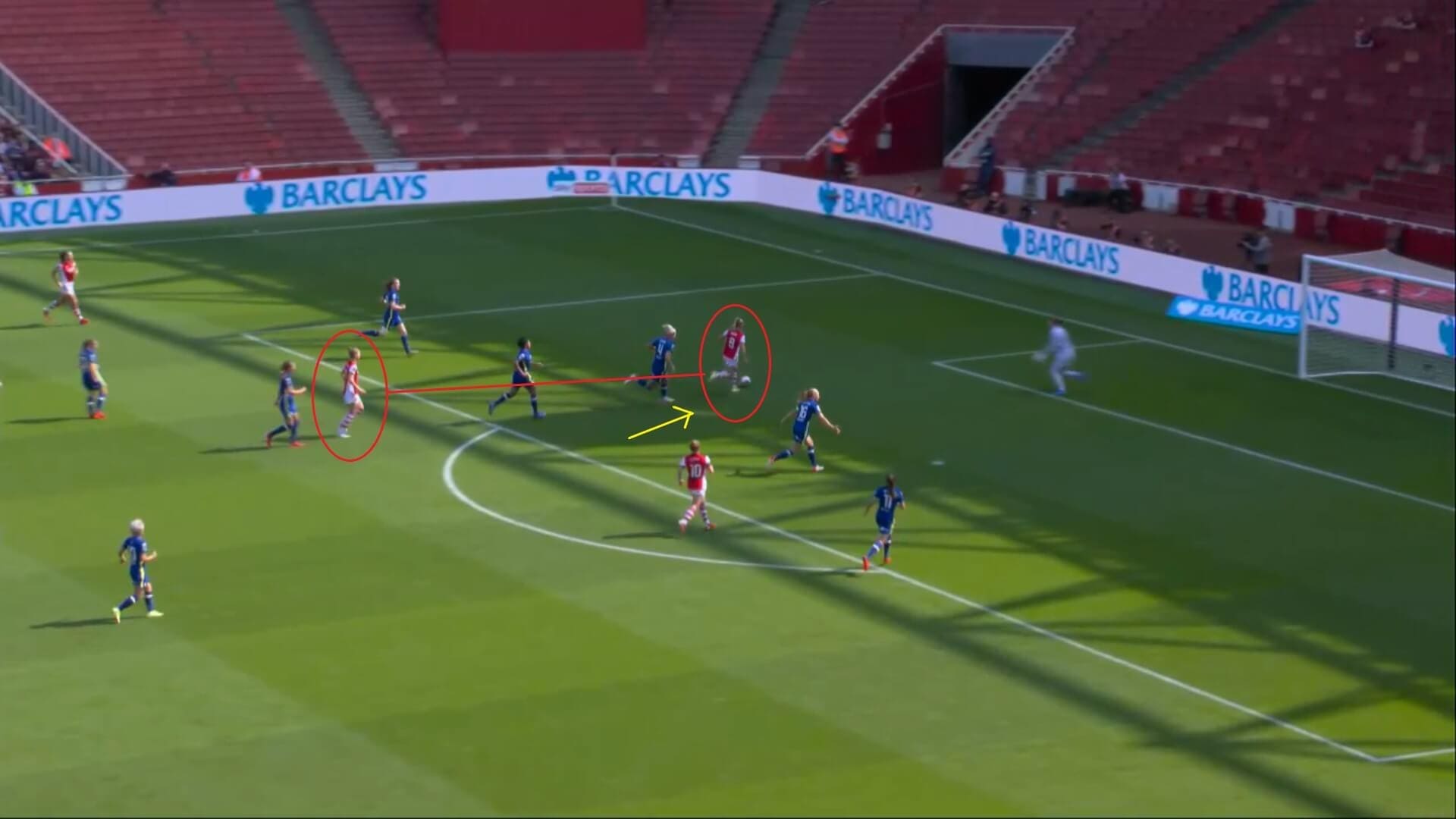
We have already mentioned how Beth Mead was the target player for Arsenal in the final third, but there was more to her game than simply getting into those positions. There seemed to be a tactical understanding between the England player and Miedema throughout the game, with the Dutch international dropping back into an attacking midfield position for most of the second half, whilst Mead played in the space she had vacated at the top of the pitch. Miedema was now free to receive the ball and pass forwards, acting as a pivot in Arsenal’s attack, knowing that Mead would be there to receive the ball when she released it.
We know that Miedema drifts around the field during games, and she often appeared on the wings last season in her desire to have the ball. This was different though, and had more to do with Jonas Eidevall using his players’ individual strengths to benefit the whole team, which will be encouraging for Arsenal fans to hear as they strive to end their wait for the league title. It will be interesting to see how this partnership between Miedema and Mead develops as the season goes on, because it could be what Eidevall builds their attack around.
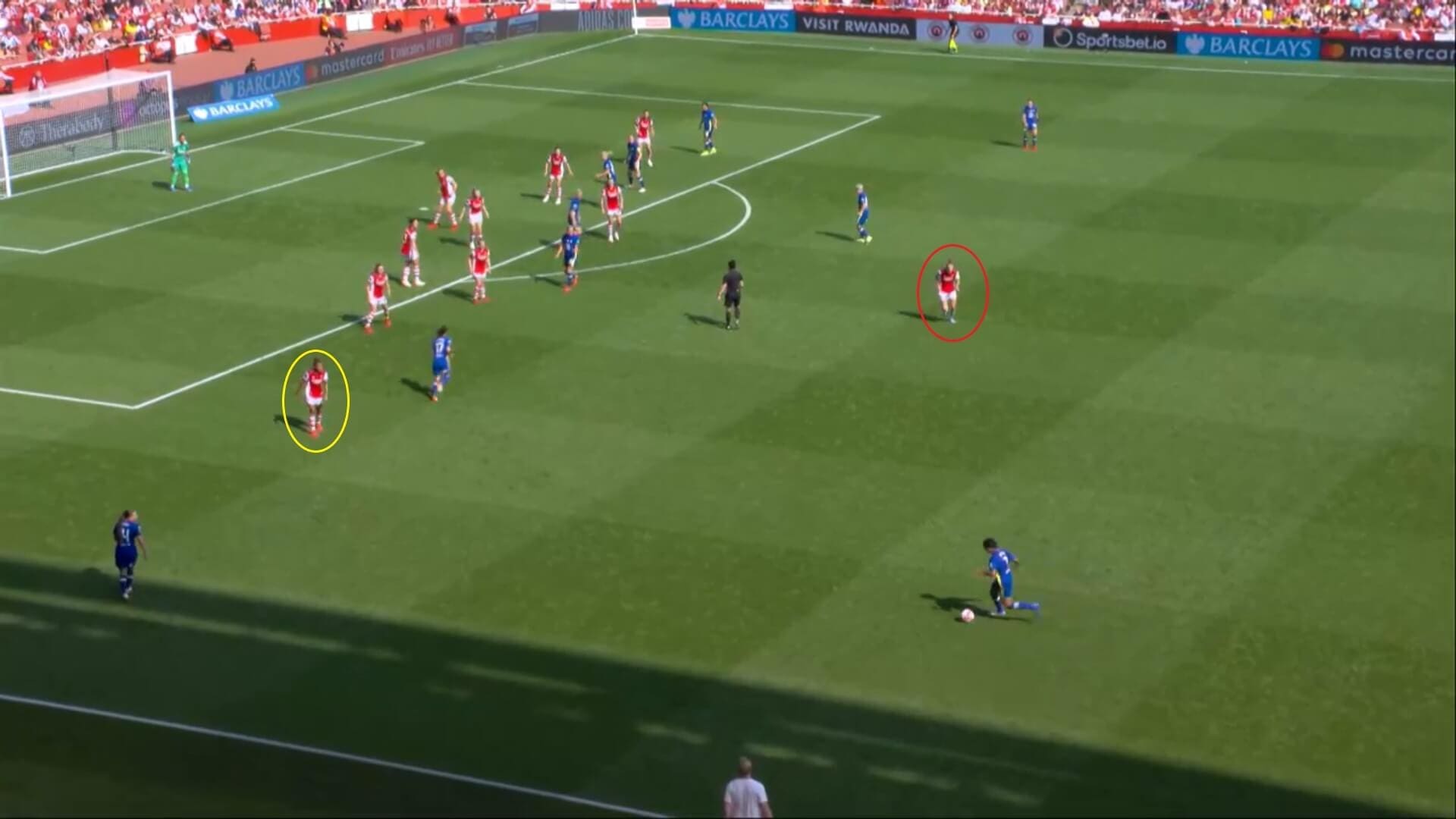
The theme of Miedema having a free role behind the main attacker was also notable in Arsenal’s defensive play. In the second half, the home side narrowed and became more compact, forcing Chelsea to play around or through them and picking off any aerial passes that they attempted. They also sat back more, just as Chelsea had in the first part of the game, limiting the space the visitors had to play in.
It was interesting that Miedema came back to sit in front of the main defensive group, using her skill to put pressure on the Chelsea players, but she didn’t get forward when Arsenal did win the ball. Instead, substitute Nikita Parris, Arsenal’s summer arrival from Lyon Feminin, had that task, and this was clearly something else that Jonas Eidevall had thought about beforehand. Therefore, we can see how their tactics and adaptability were essential in helping them to win the game, and will be important as the season goes on.
Conclusion
In conclusion, when we consider the different situations highlighted in this analysis, it is not hard to see why Arsenal Women came out on top against Chelsea Women in this pulsating encounter. However, we mustn’t get too carried away with this, as Chelsea did pose a threat, but lacked overall quality and made mistakes with their passing and decision-making at times. Emma Hayes described her team as “rusty”, and, once they are back in their usual rhythm, they will play better than they did here. Ultimately, though, there will be some who will draw conclusions from this result, as it could be decisive in the WSL title fight, and it is hard to disagree that Arsenal, for the moment at least, are now in a promising position.
Arsenal’s next game sees them travel to Slavia Prague for the second leg of their Champions League qualifying second round tie, before a trip to Reading Women next weekend. Chelsea, meanwhile, will look to score their first points of the season when they host Everton Women at Kingsmeadow.





Comments